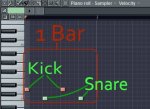OK, so I'm back with a large example
I avoided using the redrum interface for these descriptions because it would have meant way too many large images. Secondly, and probably more importantly, I'm using a grid to show these patterns so they are equally valuable to any daw user.
The grid layout is from top to bottom
Hats
Snare 2
Snare 1
Kick 2
Kick 1
So first up I avoided the whole issue of using 2 sections of redrum (i.e. more than 16 steps) by limiting myself to writing in triplet 16ths and writing half-bar patterns.
Here are my four main 1/2 bar patterns:
.
.
.
I then created a variation for each of these patterns, mostly a second snare hit:
.
.
.
Each pattern is then exported to a track. They are then quantised using iterative quantise and random ticks of the grid set to 4 (Reason (F8) tools palette). next they have their velocities randomised by 4% several times, then scaled by 75% to bring them under the 100 velocity point.
This gives us the following audio:
[mp3]http://www.bandcoach.org/fp/audio/pattern-01.mp3[/mp3]
[mp3]http://www.bandcoach.org/fp/audio/pattern-02.mp3[/mp3]
[mp3]http://www.bandcoach.org/fp/audio/pattern-03.mp3[/mp3]
[mp3]http://www.bandcoach.org/fp/audio/pattern-04.mp3[/mp3]
[mp3]http://www.bandcoach.org/fp/audio/pattern-05.mp3[/mp3]
[mp3]http://www.bandcoach.org/fp/audio/pattern-06.mp3[/mp3]
[mp3]http://www.bandcoach.org/fp/audio/pattern-07.mp3[/mp3]
[mp3]http://www.bandcoach.org/fp/audio/pattern-08.mp3[/mp3]
The trick then is to combine these patterns into full bar patterns. This gives 64 different patterns to choose from. Some will be ok, some will suck, some will be great. Only you can tell for sure.
Patterns 1-8 followed by pattern 1
[mp3]http://www.bandcoach.org/fp/audio/patterns1-08.mp3[/mp3]
Patterns 1-8 followed by pattern 2
[mp3]http://www.bandcoach.org/fp/audio/patterns2-08.mp3[/mp3]
Patterns 1-8 followed by pattern 3
[mp3]http://www.bandcoach.org/fp/audio/patterns3-08.mp3[/mp3]
Patterns 1-8 followed by pattern 4
[mp3]http://www.bandcoach.org/fp/audio/patterns4-08.mp3[/mp3]
Patterns 1-8 followed by pattern 5
[mp3]http://www.bandcoach.org/fp/audio/patterns5-08.mp3[/mp3]
Patterns 1-8 followed by pattern 6
[mp3]http://www.bandcoach.org/fp/audio/patterns6-08.mp3[/mp3]
Patterns 1-8 followed by pattern 7
[mp3]http://www.bandcoach.org/fp/audio/patterns7-08.mp3[/mp3]
Patterns 1-8 followed by pattern 8
[mp3]http://www.bandcoach.org/fp/audio/patterns8-08.mp3[/mp3]
Lastly, a banner sized example of all the patterns and how they combine to make up full bars. Don't forget that the grid represents
Hats
Snare 2
Snare 1
Kick 2
Kick 1
from top to bottom

click to open full size version













